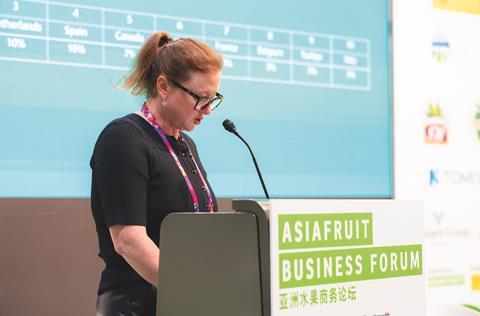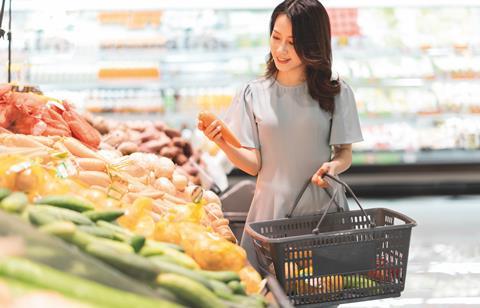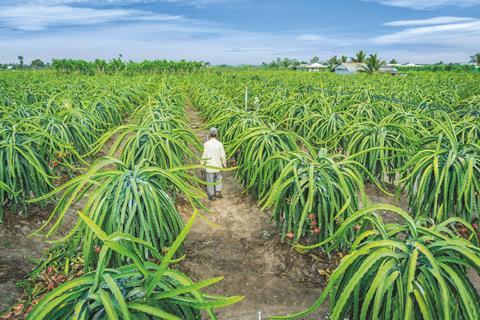The vast and diverse Asian consumer market provides plentiful opportunities for the fresh produce trade, despite various challenges

Consumers across Asia are grappling with changing shopping and eating habits against a backdrop of uncertainty and change.
At a special session organised by the International Fresh Produce Association (IFPA) at the Asiafruit Business Forum in Hong Kong on 4 September, the organisation’s vice president of global industry relations Jessica Keller detailed the latest social and economic trends affecting the Asian market.
Keller began by outlining how tough the current outlook is, explaining that fully understanding market dynamics is essential to increasing sales in the region and tapping into modern consumer desires. “We are living in unprecedented times, and from digital transformation to shifting consumption patterns and rising global instability, it’s proving harder and harder when it feels like the goalposts are always moving further and further away,” she said.
Keller spoke of the IFPA’s concept of the ‘E3 wave’, which is to say the three key strands of Economic, Environmental and Emotional, and how these help understanding of consumer dynamics.
Economic

The good news is that according to the IMF, the outlook in Asia has actually brightened in 2024. The region’s economy is set to slow less than previously projected as inflationary pressures dissipate, and the IMF has raised the regional growth forecast for 2024 to 4.5 per cent, up 0.3 percentage points from six months earlier.
Turning her attention to international trade flows, Keller stressed that Asia continues to be a significant player in the global export market. Of the world’s top ten fruit exporting nations, three are in Asia, with Thailand in fifth place with a five per cent share, and Vietnam and China in seventh and eight respectively with four per cent each. China is also the world’s largest exporter of vegetables, with a 12 per cent share.
China’s major exports include garlic, mushrooms, onions and leafy greens, while dragonfruit and durian are leading products exported from Vietnam. Indeed, it has been a good year for Vietnam, which saw a 56 per cent increase in vegetable exports to reach a record $3.5bn. “Overall the region’s export market remains robust, driven by demand and favourable trade conditions,” Keller said.
Despite that positivity, it’s a mixed bag on inflation in the region. While Thailand and China have seen consumer prices fall in the past year, Keller noted that Australia, New Zealand and South Korea still have persistently high inflation. Extreme weather events and disrupted global supply chains have also meant fruit and vegetable inflation has been a significant issue in Asia.
Importantly, despite Asian consumers generally being cautious in their spending this year, research suggests fresh produce is still considered a vital purchase. “Indian consumers expressed positive spending intent for essential and semi-essential items including produce,” Keller pointed out. “Chinese consumers intend to spend more in categories like fresh produce, fitness and wellness, and less for food delivery and non-alcoholic beverages. In Japan and Australia, net spending intent is largely negative except for a few essential categories such as groceries and gasoline.”
Environmental

The delicate balance between food safety and plastic reduction is as live an issue in Asia as it is in Europe. Last year, China announced restrictions on the overpackaging of food, while India is banning single-use plastics, Japan and South Korea have committed to a 2050 carbon neutral deadline, and Singapore has an ambitious green plan that reduces landfill waste by 30 per cent per capita per day by 2030.
“In response to packaging regulations, IFPA formed the Alliance for Sustainable Packaging for Foods with associations from around the world including colleagues in the meat and dairy industries, to ensure packaging decisions take into account critical issues like food safety and shelf life,” Keller explained.
On a personal level, consumers are feeling apprehensive, according to Keller, who noted that half of the global population will be voting in national elections over the course of this year. Elections are causing political uncertainty in nations including Indonesia, India, Taiwan, Pakistan, Sri Lanka, South Korea, and Mongolia, while the rise of artificial intelligence is also adding general anxiety and uncertainty as people worry they may lose their jobs to algorithms.
With countries such as China, India and Indonesia all reporting an increase in child and adolescent obesity rates over the past decade, themes of health and wellness are also continuing to gain traction in Asia.
Finally, as lives become busier and eating habits change, snackification is also becoming a new trend in Asia, Keller said. According to IFPA research in Vietnam, for example, 86 per cent of people surveyed said they are likely to choose a fruit as a snack and 78 per cent are likely to choose a vegetable, suggesting a valuable avenue for the fresh produce industry.



